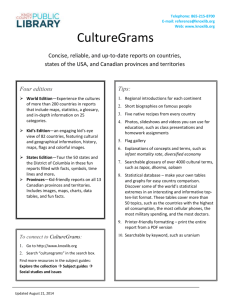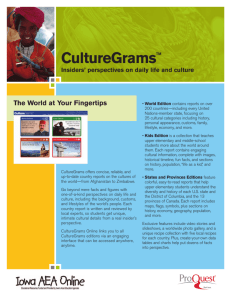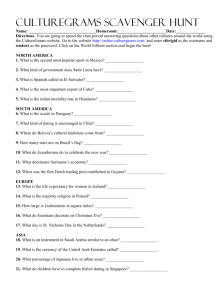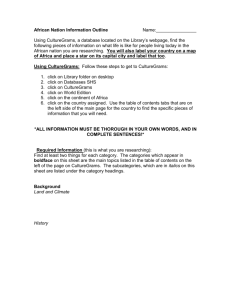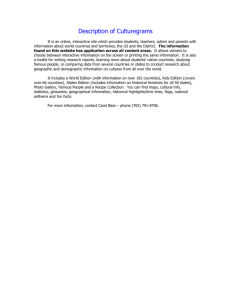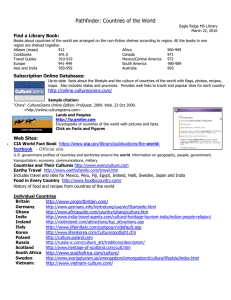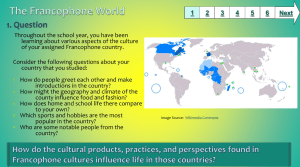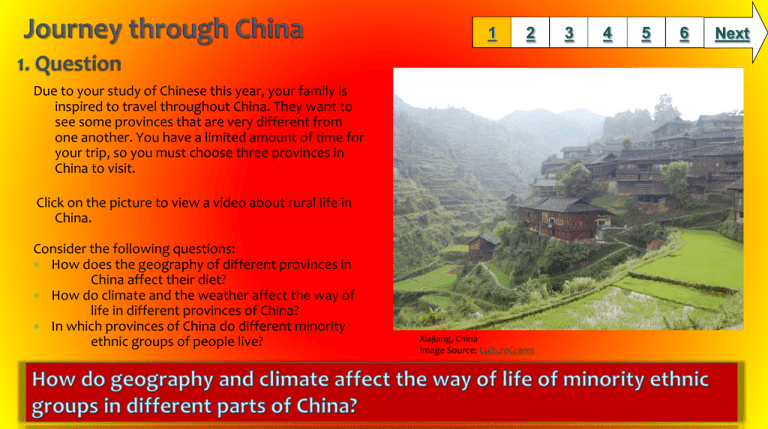
1
2
Due to your study of Chinese this year, your family is
inspired to travel throughout China. They want to
see some provinces that are very different from
one another. You have a limited amount of time for
your trip, so you must choose three provinces in
China to visit.
Click on the picture to view a video about rural life in
China.
Consider the following questions:
How does the geography of different provinces in
China affect their diet?
How do climate and the weather affect the way of
life in different provinces of China?
In which provinces of China do different minority
ethnic groups of people live?
Xiajiang, China
Image Source: CultureGrams
3
4
5
6
Next
1
2
3
4
Use the following resources to help you choose which
provinces you will visit in China. Remember to choose
provinces that are very different from one another.
Scribble Maps (tutorial)
CultureGrams (password required outside of school- see
your School Library Media Specialist)
Library of Congress country studies- China (focus on
chapters 2 & 6)
National Geographic video: Climbing China’s Incredible
Cliffs
China Today: Chinese cities and provinces
Travel China Guide: Chinese Ethnic Groups
As you research, take notes using a graphic organizer found on
the next page. Don’t forget to cite your sources!
Click on the map to view in Chinese.
Image Source: CultureGrams
Silver= I can do this on my own
Gold= Challenge me!
5
6
Next
1
You will use the resources from the previous slide to
take notes about the three provinces that you
have chosen to visit in China.
Use this graphic organizer to take your notes. Be
sure to complete all of the categories including
geography, weather/ climate, diet, minority ethnic
groups, way of life, URLs where you found the
information, and MLA citations of your sources.
Please see the rubric for more details about how
your notes will be graded.
Nomads in Lhasa, Tibet
Image Source: CultureGrams
2
3
4
5
6
Next
1
2
Now use your notes from your graphic organizer to
create an MS Publisher brochure in Chinese about
your journey. Be sure to include all of the information
from your notes. Also include a map (Scribble Maps)
in your brochure that outlines the provinces that you
chose. Be sure to make connections between the
different categories in your notes.
Use images in your brochure that are copyright-free or
from sources licensed by BCPS.
You will present your brochure out loud in front of the
class. Be prepared to speak on the date that your
teacher assigns.
Be sure to review the rubric to make sure that you have
met all of the requirements for your presentation.
Li River, Guilin, China
Image Source: CultureGrams
3
4
5
6
Next
1
2
3
4
5
6
Now that you have learned about some typical
foods for the province that you chose, you
want to learn how to make a traditional food
that interests you. In Chinese, write a recipe
for your food. Use the following sources to
help you:
CultureGrams recipe collection
China Highlights: regional cuisines
CNN travel: A guide to China’s regional
specialties
Include your recipe as part of your brochure.
Image Source: CultureGrams
Next
1
Grade Level and Content Area
Maryland State Curriculum
1.2 Understand and interpret the target language in its spoken and written form on a variety of topics.
1.3 Present information, concepts, and ideas to an audience of listeners or readers on a variety of topics in
the target language.
3.1 Reinforce and further knowledge of other disciplines through a language other than English.
5.1 Students use the language both within and beyond the school setting.
Common Core State Standards
Reading: 1. Read closely to determine what the text says explicitly and to make logical inferences from it;
cite specific textual evidence when writing or speaking to support conclusions drawn from the text.
Writing: 7. Conduct short as well as more sustained research projects based on focused questions,
demonstrating understanding of the subject under investigation.
Standards for the 21st Century Learner
1.1.6 Read, view, and listen for information presented in any format (e.g. textual, visual, media, digital) in
order to make inferences and gather meaning.
2.1.3 Use strategies to draw conclusions from information and apply knowledge to curricular areas, realworld situations, and further investigations.
ISTE NETS - National Educational Technology Standards for Students
3. Research and Information Fluency: Students apply digital tools to gather, evaluate, and use information.
b. Locate, organize, analyze, evaluate, synthesize, and ethically use information from a variety of
sources and media.
4. Critical Thinking, Problem Solving, and Decision Making: Students use critical thinking skills to plan and
conduct research, manage projects, solve problems, and make informed decisions using appropriate
digital tools and resources. c. Collect and analyze data to identify solutions and/or make informed
decisions.
2
3
4
5
6
Time Frame:
Two 90 minute class periods. An additional class period may be
required for oral presentations.
Differentiation strategies for this lesson:
Direct students to use learning tools included in our BCPSlicensed databases, such as: audio read-aloud, labeled reading
levels/ Lexiles, and embedded dictionaries.
Learning Styles addressed in this lesson:
Visual, auditory, tactile, reflective, global understanding
Notes to the teacher:
Collaborate with your school library media specialist to
implement this lesson.
This Slam Dunk lesson is designed for a level 3+ Chinese class.
You may want to use part of the class period before you take
your students to the library media center to introduce the Slam Dunk
and to show/model what students will be creating.
You may wish to use a website such as Edmodo to distribute and
collect student assignments electronically.
You may want to add point values to the rubrics.
If you have an Elmo projector available, you may want to allow
students to use it to present their brochures.
Last updated: July 2014
Created by Amber Bickhart, School Library Media Intern
BCPS Slam Dunk Research Model, Copyright 2014, Baltimore County Public Schools, MD, all rights reserved. The models may be used for educational, non-profit school use only.
All other uses, transmissions, and duplications are prohibited unless permission is granted expressly. This lesson is based on Jamie McKenzie’s Slam Dunk Lesson module.

